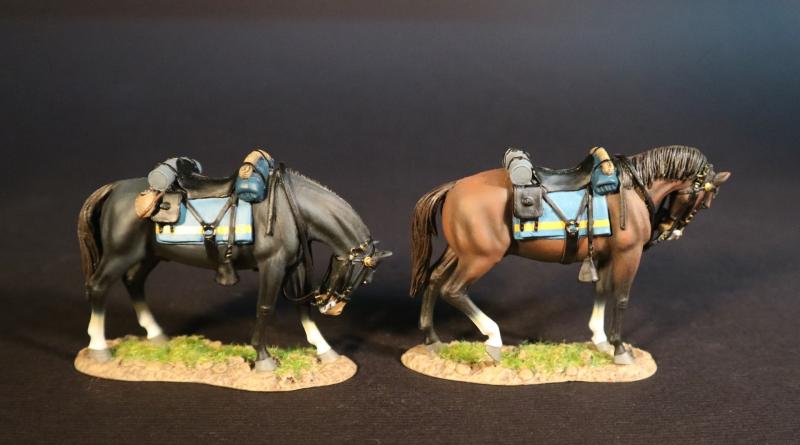Two United States Cavalry Horses (brown looking forward, black looking down), United States Cavalry, The Battle of the Rosebud, 17th June 1876, The Black Hill Wars 1876-1877--two horse figures
$98.00
Item Number: HRSBUD-01B
Two United States Cavalry Horses (brown looking forward, black looking down), United States Cavalry, The Battle of the Rosebud, 17th June 1876, The Black Hill Wars 1876-1877
THE BATTLE OF THE ROSEBUD, 17th JUNE 1876, THE BLACK HILL WARS, 1876-1877, THUNDER ON THE PLAINS
UNITED STATES CAVALRY
As settlers spread westward across North America after 1780, armed conflicts increased in size, duration, and intensity between settlers and various Indian and First Nation tribes.
In 1875, the Great Sioux War of 1876-77 erupted when the Dakota gold rush penetrated the Black Hills. The U.S government decided to stop evicting trespassers from the Black Hills and offered to buy the land from the Sioux. When they refused, the U.S. government decided instead to take the land and gave the Lakota until January 31st, 1876 to return to reservations.
An United States cavalry regiment in 1876 consisted of 12 companies. A cavalry company, at full strength had 3 officers and 70 enlisted men. The U.S. cavalry of 1876 used Lt. Col. Emory Upton’s Cavalry Tactics, which was an unified system of drill, which was compatible among the cavalry, infantry and artillery. This meant an officer could move from one branch of service to another. Upton’s tactics incorporated a “set of fours” as the basic, or smallest, cavalry unit or squad. This was designed to simplify operations, increase speed, and eliminate cumbersome manoeuvres.
Dismounted skirmishing became the main cavalry mode of engagement with the enemy, which facilitated the dispersal of men on a firing line.
On campaign and in battle, cavalrymen did not always perform as mounted skirmishers but rather served as mounted infantry. By dismounting and kneeling under fire, the trooper presented a much smaller target for the enemy and could take aim much more accurately.
The preparatory command “to fight on foot”, followed by “As skirmishers”, required each cavalryman to dismount and deploy along a firing line at 5yd intervals, with 15 yard gaps between each set of four men. Odd numbered skirmishers in each set of four fired a round on command and then reloaded as even numbered skirmishers fired on order. Each man then continued to fire roughly in an odd-even sequence without regard to the others until “Cease fire” command was given. Skirmish tactics could be employed by the platoon, company, battalion or even at regimental level. Dismounted skirmishing required one of every four men, designated as a horse holder, to remain with the horses of the other three. Horse holders retired to a safe position in the rear.
On 28th May 1876, Brigadier General George Crook assumed direct command of the Bighorn and Yellowstone Expedition at Fort Fetterman. Crook had gathered a strong force. Leaving Fort Fetterman on 29th May, the 1,051-man column consisted of 15 companies from the 2nd and 3rd Cavalry, 5 companies from the 4th and 9th Infantry, 250 mules, and 106 wagons.
On the 14th June, the column was joined by 261 Shoshone and Crow allies.
Based on intelligence reports, Crook ordered his entire force to prepare for a quick march. Each man was to carry only 1 blanket, 100 rounds of ammunition, and 4 days rations. The wagon train would be left at Goose Creek, and the infantry would be mounted on the pack mules.
On 17 June, Crook's column set out at 0600, marching northward along the south fork of Rosebud Creek. The Crow and Shoshone scouts were particularly apprehensive. Although the column had not yet encountered any sign of Indians, the scouts seemed to sense their presence. The soldiers, particularly the mule-riding infantry, seemed fatigued from the early start and the previous day's 35-mile (56 km) march. Accordingly, Crook stopped to rest his men and animals at 0800. Although he was deep in hostile territory, Crook made no special dispositions for defense. His troops halted in their marching order. The Cavalry battalions led the column, followed by the battalion of mule-borne foot soldiers, and a provisional company of civilian miners and packers brought up the rear.
The Crow and Shoshone scouts remained alert while the soldiers rested. Several minutes later, the soldiers heard the sound of intermittent gunfire coming from the bluffs to the north. As the intensity of fire increased, a scout rushed into the camp shouting, "Lakota, Lakota!" The Battle of the Rosebud had started. By 0830, the Sioux and Cheyenne had hotly engaged Crook's Indian allies on the high ground north of the main body. Heavily outnumbered, the Crow and Shoshone scouts fell back toward the camp, but their fighting withdrawal gave Crook time to deploy his forces. Rapidly firing soldiers drove off the attackers, but used up much of the ammunition meant for use later in the campaign. Low on ammunition and with numerous wounded, the General returned to his post.
Historians debate whether Crook’s pressing on could have prevented the killing of the five companies of the 7th Cavalry Regiment led by George Armstrong Custer at the Battle of the Little Bighorn
Released in AUGUST 2023.
